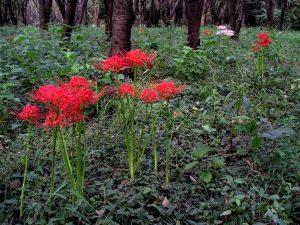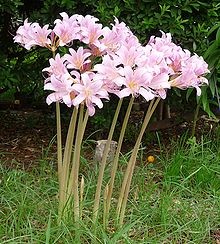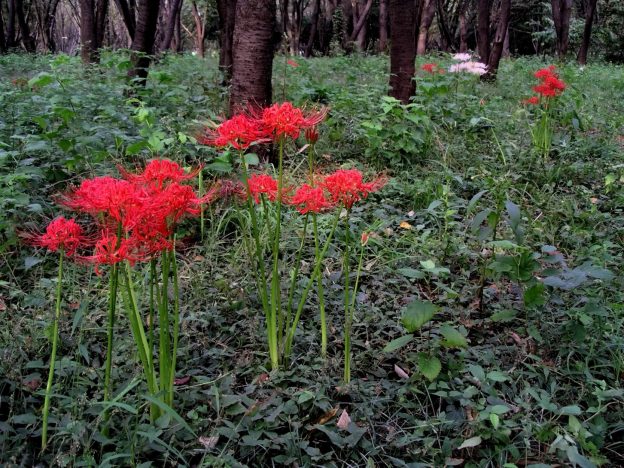Plant Profile: Lycoris
Carlton Hines, 2017 Henrico Master Gardener Intern
Lycoris is a flowering plant and perennial herb from the Amaryllis family. It is known commonly as the resurrection lily, surprise lily, spider lily, and/or hurricane lily. It grows by bulb, and never bears leaves and flowers at the same time. Its leaves are strap or lance-shaped, its flowers contain three to six petals, and their fruits are either in the form of fleshy berries or dry capsules.

Photo Credit: By Blue Lotus – Flickr, CC BY 2.0, https://commons.wikimedia.org/w/index.php?curid=1215482
Blue-green foliage grows in the fall through spring from a bulb, then dies back to the ground without a single bloom. After “taking much of the summer off” they suddenly erupt with growth. Within a 5-day period, they reach heights of 18 inches, boasting circular clusters of 2-inch-long flowers. The backward curving sepals and petals, combined with long, upwardly arcing pistols and stamens, resemble a spider. The flowers bloom for several weeks, coinciding with hurricane season. Only two species of Lycoris are readily available in the United States, which are Lycoris radiata and Lycoris squamigera.
Lycoris radiata are the least winter hardy species, growing in USDA Plant Hardiness zones 6-10. Bulbs require 9” spacing with the top ¼” exposed. They grow 12”-18” tall with an equal spread. Red, non-fragrant, showy flowers bloom between August and September in full sun to part shade with medium water requirements and medium maintenance. Flowers will prefer some shade in warmer climates. The naked flower scapes bear an umbel and 4-6 light coral red flowers. Leaves appear in fall, overwintering and lasting through spring. L. radiata are not prone to pest and insect damage.
Lycoris squamigera are more cold hardy, growing in USDA Plant Hardiness zones 5-9. Bulbs should be planted 5”-6” deep and spaced 6” apart. They grow 12”-18” tall with an equal spread. The naked flower scapes begin their growth in late summer to bear 4-7 funnel-shaped flowers that are fragrant and rose pink in color. Flowers bloom August to September in full sun or part shade with medium water requirements and low maintenance. L. squamigera is called the “magic lily” and is found typically in shady woodlands. Plants are not prone to pest and insect damage.

Photo Credit: By Namazu-tron (Self Shot) [GFDL (http://www.gnu.org/copyleft/fdl.html) or CC BY-SA 3.0 (http://creativecommons.org/licenses/by-sa/3.0)], via Wikimedia Commons
In warmer regions, growth begins in fall, enduring through spring. In colder regions leaf growth starts in spring. Leaves die back without too much of a mess, leaving a nitrogen-rich food source for its bulb. Harsh winters may diminish flower hardiness, which can prevent them from flowering the following summer. If growing in pots, bulbs require a large growing space with potential for deep root development. Containers that are too small will cause “failure to thrive” syndrome and not flower at all.

